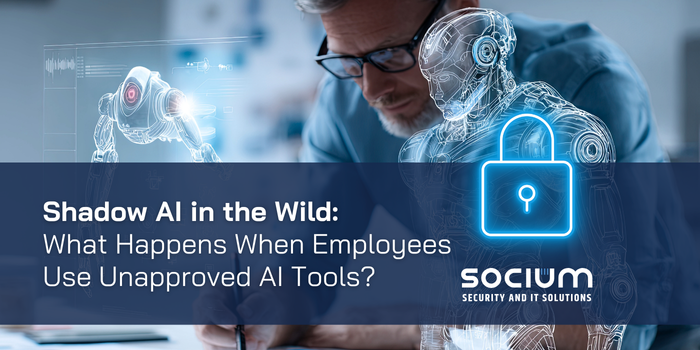Artificial intelligence is transforming how we work, streamlining tasks, generating content, and accelerating decision-making across every industry. But while organizations rush to understand and adopt AI responsibly, employees are taking matters into their own hands. Without waiting for official approval, many are turning to public AI tools to help them keep up with day-to-day demands. This quiet, unregulated use of AI inside businesses is known as shadow AI, and it’s becoming one of the fastest-growing cybersecurity threats today. At Socium Solutions, we’ve seen firsthand how quickly shadow AI can take root in an organization, often without anyone noticing until sensitive data has already left the building.
Shadow AI isn’t always dramatic; it often starts with a well-meaning employee who just wants to save time. Someone pastes a client’s information into a public chatbot to rewrite an email. A manager asks an AI tool to summarize confidential meeting notes. A developer uses an unapproved code-generation extension because it makes their job easier. These actions feel harmless, but they create significant risk because the organization has no visibility or control over the tools being used.
Most employees don’t intend to bypass security; they simply don’t realize the stakes. AI platforms are fast, convenient, and increasingly integrated into everyday workflows. The most immediate concern with shadow AI is data leakage. Many public AI tools store user inputs, use them to train future models, or share them across multiple systems and vendors. When employees enter internal documents, client details, financial data, or proprietary code into these platforms, that information may end up outside the organization forever.
Compliance risks follow closely behind. Regulations like GDPR, HIPAA, and PCI-DSS impose strict requirements on how data is handled, stored, and transmitted. A single unauthorized AI interaction, especially involving personally identifiable or sensitive data, can trigger costly investigations, penalties, and contractual violations. Even companies with strong cybersecurity programs can find themselves blindsided because shadow AI operates outside formal processes.
Another overlooked risk is the introduction of insecure or inaccurate AI-generated output. Developers, for example, may unknowingly inject flawed or vulnerable code into production environments. AI-generated content may include copyrighted material or inaccurate information presented with unwarranted confidence. The more organizations rely on AI informally, the harder it becomes to maintain quality, security, and accountability.
And finally, not all AI tools are what they claim to be. Malicious browser extensions, unverified productivity apps, and fake “AI assistants” frequently circulate online. These tools quietly harvest data, monitor activity, or open the door to broader compromise. Shadow AI makes it easy for these threats to slip into a company’s environment unnoticed.
The solution isn’t to ban AI outright; employees will simply find workarounds. The real path forward is to create a culture where AI can be used safely, responsibly, and transparently. That begins with establishing a clear, accessible AI usage policy that outlines what employees can use, what data is off-limits, and where the boundaries of acceptable AI behavior lie. A thoughtful policy immediately reduces risk by giving your team the clarity they’re currently lacking.
From there, organizations should offer secure, approved AI tools so employees have reliable alternatives to public platforms. When people have vetted, compliant options at their fingertips, reliance on shadow AI naturally declines. This should be paired with monitoring and technical safeguards, such as DLP rules, endpoint controls, and AI-specific traffic visibility, to detect unapproved usage before it becomes a breach.
Finally, education is essential. Employees need to understand why shadow AI is dangerous, what kinds of data should never be shared with external systems, and how to recognize unsafe tools. Training transforms AI from a hidden liability into a competitive advantage. This is where Socium Solutions brings tremendous value.
We work with businesses to uncover where shadow AI is already occurring, assess how much risk it has introduced, and build a secure and sustainable AI strategy. Our team helps organizations:
- Identify unapproved or risky AI usage
- Assess data exposure and compliance impact
- Implement safe, approved AI solutions
- Deploy technical controls for oversight and monitoring
- Train employees on secure AI practices
Shadow AI isn’t a fringe issue or a future threat; it’s happening right now inside organizations everywhere. The only question is whether you have visibility into it or not. With the guidance and support of Socium Solutions, you can turn shadow AI from an uncontrolled security risk into a well-governed, business-driving asset. Contact us today to get started.

